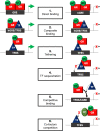New insights into the cell- and tissue-specificity of glucocorticoid actions
- PMID: 32868909
- PMCID: PMC7456664
- DOI: 10.1038/s41423-020-00526-2
New insights into the cell- and tissue-specificity of glucocorticoid actions
Abstract
Glucocorticoids (GCs) are endogenous hormones that are crucial for the homeostasis of the organism and adaptation to the external environment. Because of their anti-inflammatory effects, synthetic GCs are also extensively used in clinical practice. However, almost all cells in the body are sensitive to GC regulation. As a result, these mediators have pleiotropic effects, which may be undesirable or detrimental to human health. Here, we summarize the recent findings that contribute to deciphering the molecular mechanisms downstream of glucocorticoid receptor activation. We also discuss the complex role of GCs in infectious diseases such as sepsis and COVID-19, in which the balance between pathogen elimination and protection against excessive inflammation and immunopathology needs to be tightly regulated. An understanding of the cell type- and context-specific actions of GCs from the molecular to the organismal level would help to optimize their therapeutic use.
Keywords: Glucocorticoids; immune response; inflammation.
Conflict of interest statement
The authors declare no competing interests.
Figures



Similar articles
-
Generalized and tissue specific glucocorticoid resistance.Mol Cell Endocrinol. 2021 Jun 15;530:111277. doi: 10.1016/j.mce.2021.111277. Epub 2021 Apr 14. Mol Cell Endocrinol. 2021. PMID: 33864884 Review.
-
Homeostatic Regulation of Glucocorticoid Receptor Activity by Hypoxia-Inducible Factor 1: From Physiology to Clinic.Cells. 2021 Dec 7;10(12):3441. doi: 10.3390/cells10123441. Cells. 2021. PMID: 34943949 Free PMC article. Review.
-
New insights into the anti-inflammatory mechanisms of glucocorticoids: an emerging role for glucocorticoid-receptor-mediated transactivation.Endocrinology. 2013 Mar;154(3):993-1007. doi: 10.1210/en.2012-2045. Epub 2013 Feb 5. Endocrinology. 2013. PMID: 23384835 Review.
-
Therapeutic Mechanisms of Glucocorticoids.Trends Endocrinol Metab. 2018 Jan;29(1):42-54. doi: 10.1016/j.tem.2017.10.010. Epub 2017 Nov 20. Trends Endocrinol Metab. 2018. PMID: 29162310 Review.
-
Roles of the Glucocorticoid and Mineralocorticoid Receptors in Skin Pathophysiology.Int J Mol Sci. 2018 Jun 29;19(7):1906. doi: 10.3390/ijms19071906. Int J Mol Sci. 2018. PMID: 29966221 Free PMC article. Review.
Cited by
-
Glucocorticoids activate Yes-associated protein in human vocal fold fibroblasts.Exp Cell Res. 2021 Aug 15;405(2):112681. doi: 10.1016/j.yexcr.2021.112681. Epub 2021 Jun 2. Exp Cell Res. 2021. PMID: 34087241 Free PMC article.
-
Prenatal Activation of Glucocorticoid Receptors Induces Memory Impairment in a Sex-Dependent Manner: Role of Cyclooxygenase-2.Mol Neurobiol. 2022 Jun;59(6):3767-3777. doi: 10.1007/s12035-022-02820-8. Epub 2022 Apr 9. Mol Neurobiol. 2022. PMID: 35396693
-
Factors associated with critical care requirements in diabetic patients treated with dexamethasone for COVID-19 infection in the first wave of the pandemia.Front Endocrinol (Lausanne). 2022 Dec 22;13:1009028. doi: 10.3389/fendo.2022.1009028. eCollection 2022. Front Endocrinol (Lausanne). 2022. PMID: 36619546 Free PMC article.
-
Stress hormone signalling inhibits Th1 polarization in a CD4 T-cell-intrinsic manner via mTORC1 and the circadian gene PER1.Immunology. 2022 Apr;165(4):428-444. doi: 10.1111/imm.13448. Epub 2022 Mar 2. Immunology. 2022. PMID: 35143696 Free PMC article.
-
Holistic Rehabilitation: Biological Embedding of Social Adversity and Its Health Implications.Phys Ther. 2022 Jan 1;102(1):pzab245. doi: 10.1093/ptj/pzab245. Phys Ther. 2022. PMID: 34718801 Free PMC article.
References
-
- Cole TJ, et al. Targeted disruption of the glucocorticoid receptor gene blocks adrenergic chromaffin cell development and severely retards lung maturation. Genes Dev. 1995;9:1608–1621. - PubMed
-
- Vandewalle J, Luypaert A, De Bosscher K, Libert C. Therapeutic mechanisms of glucocorticoids. Trends Endocrinol. Metab. 2018;29:42–54. - PubMed
-
- Frei E, 3rd, et al. The effectiveness of combinations of antileukemic agents in inducing and maintaining remission in children with acute leukemia. Blood. 1965;26:642–656. - PubMed
-
- Herr I, Pfitzenmaier J. Glucocorticoid use in prostate cancer and other solid tumours: implications for effectiveness of cytotoxic treatment and metastases. Lancet Oncol. 2006;7:425–430. - PubMed
Publication types
MeSH terms
Substances
Grants and funding
- 800924/EC | EU Framework Programme for Research and Innovation H2020 | H2020 Priority Excellent Science | H2020 Marie Skłodowska-Curie Actions (H2020 Excellent Science - Marie Skłodowska-Curie Actions)
- 800924/EC | EU Framework Programme for Research and Innovation H2020 | H2020 Priority Excellent Science | H2020 European Research Council (H2020 Excellent Science - European Research Council)
- ANR-14-CE14-0009-01/Agence Nationale de la Recherche (French National Research Agency)
LinkOut - more resources
Full Text Sources
Medical
Research Materials
Miscellaneous

